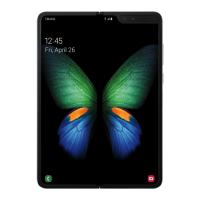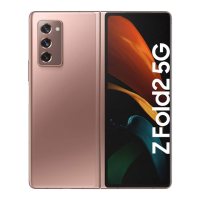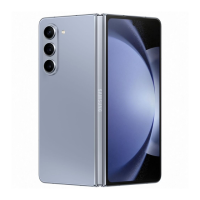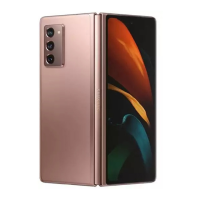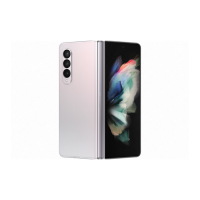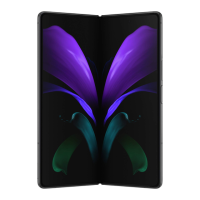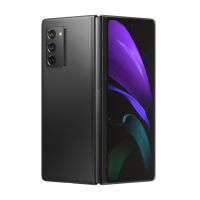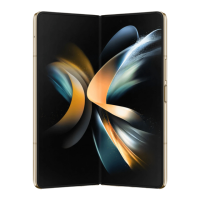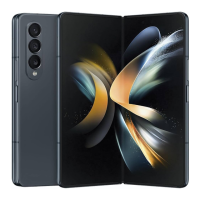
Do you have a question about the Samsung Galaxy Fold and is the answer not in the manual?
| RAM | 12GB |
|---|---|
| Internal Storage | 512GB |
| Weight | 263g |
| SIM | Nano-SIM, eSIM |
| Colors | Cosmos Black, Space Silver, Martian Green, Astro Blue |
| GPU | Adreno 640 |
| Display (Main) | 7.3 inches, Dynamic AMOLED 2X, 1536 x 2152 pixels |
| Display (Cover) | 4.6 inches, Super AMOLED, 720 x 1680 pixels |
| Processor | Qualcomm SM8150 Snapdragon 855 (7 nm) |
| Rear Camera | 12 MP (wide) + 12 MP (telephoto) + 16 MP (ultrawide) |
| Front Camera | 10MP (f/2.2) |
| Battery | 4380 mAh |
| Operating System | Android 9.0 (Pie) |
| Chipset | Qualcomm SDM855 Snapdragon 855 (7 nm) |
Important information and precautions before using the device for safe and proper operation.
Guidance on what to do when the device heats up during charging or usage.
Overview of package contents, unfolded, and folded device layouts with component identification.
Explanation of the function of the Volume and Side keys on the device.
Description of the navigation bar soft buttons (Recents, Home, Back).
Instructions for charging the battery, reducing consumption, and charging tips.
Information on activating and installing eSIM and nano-SIM cards for dual SIM functionality.
Details about connecting and using accessories like Galaxy Buds.
Step-by-step guide on how to turn the device on, turn it off, and force restart.
Guide for setting up the device for the first time after purchase or data reset.
Information on creating, signing in, and managing a Samsung account for device services.
Instructions for transferring data using Smart Switch via USB or wirelessly.
Explanation of the front and main screens and how to use the device with one hand.
Guide to basic touchscreen gestures like tapping, tapping and holding, and dragging.
Details on the functions of the Recents, Home, and Back buttons.
Overview of the Home screen, Apps screen, and switching between them.
Instructions for downloading, installing, and managing apps from Galaxy Store and Play Store.
Introduction to Bixby, a user interface for convenient device interaction via voice or text.
Overview of Bixby Vision features for image recognition, text translation, and location search.
How to create, manage, and receive notifications for reminders based on time or location.
Guide to making and receiving calls, including call logs, speed dial, and blocking numbers.
Instructions for creating, adding, importing, syncing, and managing contacts.
How to send, view, and block messages, including notification settings.
Guide to browsing webpages, using secret mode, and managing security settings.
Steps for setting up email accounts, sending, and reading emails.
Instructions for taking photos and recording videos using various modes and lenses.
Information on video recording options, resolution, and advanced features like HEVC and HDR10+.
How to view, search, edit, and manage images and videos stored on the device.
Guide to creating and using My Emoji, character Emojis, and stickers with the camera.
How to set up and customize the Always On Display for notifications and music control.
Instructions for using split screen view and pop-up view to run multiple apps simultaneously.
Guide to setting up Samsung Pay, registering cards, and making payments.
How to manage wellness and fitness, track steps, and compete with friends using Samsung Health.
Instructions for creating and deleting notes, including inserting images or voice recordings.
How to manage schedules by creating events and reminders in the planner.
Guide to making voice recordings, changing modes, and playing back recordings.
How to access and manage files stored on the device or in cloud storage.
Features for setting alarms, world clocks, stopwatch, and timer.
How to use Game Launcher to gather games, change performance modes, and use Game Tools.
How to restrict children's access, set usage times, and configure parental controls.
Connecting to nearby devices, controlling home appliances, and managing devices by location.
Methods for sharing content, such as images, via various options like message and email.
Using the smartphone like a computer by connecting to an external display.
Overview of Google applications like Chrome, Gmail, Maps, Play Music, and Drive.
Options for changing connection settings like Wi-Fi, Bluetooth, NFC, and mobile networks.
How to connect to a Wi-Fi network and use Wi-Fi Direct for device-to-device connections.
Guide to pairing with other Bluetooth devices and managing data transfer.
Using NFC for reading product information, making payments, and sending data.
Reducing data usage by preventing background apps from sending or receiving data.
Activating and customizing eSIM and nano-SIM card settings for dual SIM functionality.
Using the device as a mobile hotspot or tethering via Wi-Fi, USB, or Bluetooth.
Customizing settings for nearby device scanning, printing, and network configurations.
Adjusting sound modes, ringtones, notification sounds, and vibration settings.
Selecting surround sound modes for audio enhancement, such as for movies and music.
Changing notification settings, including app icon badges, do not disturb, and status bar display.
Adjusting display settings like brightness, adaptive brightness, blue light filter, and night mode.
Customizing lock screen settings, including screen lock type, smart lock, and clock style.
Setting up security features like face recognition, fingerprints, Google Play Protect, and Secure Folder.
Guide to registering and using face recognition for unlocking the device and its security.
Instructions for registering, checking, and using fingerprints for device security and app access.
Using Samsung Pass to easily sign in to accounts, websites, and apps with biometric data.
Protecting private content and apps in a secure, separate storage area.
Syncing, backing up, and restoring device data using Samsung Cloud or other accounts.
Activating and configuring advanced features like Bixby Routines, Motions and gestures, and Dual Messenger.
Monitoring device usage, setting app timers, and activating wind down mode.
Overview of device status (battery, storage, memory, security) and optimizing performance.
Checking the status of used and available memory and managing device storage.
Checking device security status, scanning for malware, and managing security settings.
Customizing system settings like language, date/time, and device reset options.
Improving device usability with features for vision, hearing, and dexterity impairments.
Activating and controlling the device using voice feedback and screen reader.
Solutions for common device issues like unlock codes, network errors, and touchscreen problems.
Safety warnings and instructions regarding battery removal and device handling.
